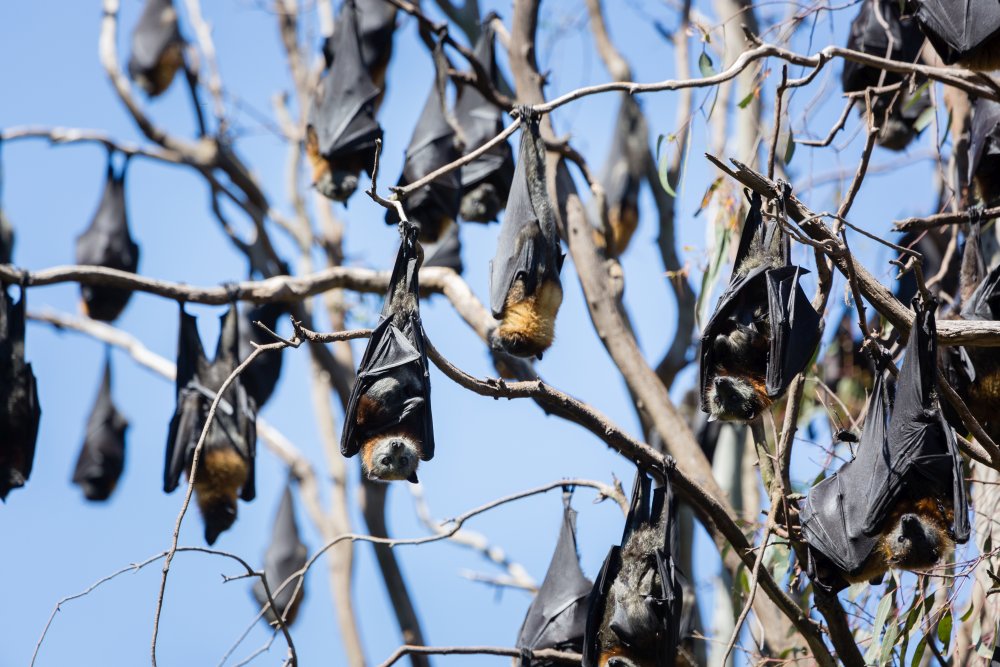
What is a wildlife extreme heat emergency?
The Department of Energy, Environment and Climate Action (DEECA) is the designated lead control agency for responding to wildlife welfare arising from a declared emergency event. Under the Victorian Emergency Management Act 2013 (EM Act) and the State Emergency Management Plan (SEMP), extreme heat is considered an emergency event.
The State Emergency Response Plan Extreme Heat Sub-Plan (Extreme Heat Sub-plan) defines activities associated with responding to wildlife welfare issues arising from an extreme heat emergency are confined to dense single native species populations.
DEECA confines wildlife extreme heat response preparedness and response activities to large flying-fox camps. While other wildlife may be impacted by an extreme heat event, this will not result in an emergency response activity by DEECA.
Flying-foxes and extreme heat
Flying-fox populations across Australia are threatened by extreme heat events and other stressors associated with human activity. Although they have evolved to deal with high temperatures for short periods, flying-foxes are not well equipped to deal with prolonged high temperatures and low humidity. During the Summer of 2019/20, heat stress caused the death of tens of thousands of flying-foxes across eastern Australia. These events are expected to become more frequent across Australia due to climate change.
Flying-foxes typically flap their wings and move down lower in the trees to escape heat from direct sunlight.
Victorian Response Plan for Heat Stress in Flying-foxes
The Victorian Response Plan for Heat Stress in Flying-foxes (the Plan) is focused on the arrangements for preparing for and responding to the impacts of extreme heat emergencies on flying-foxes in Victoria. For flying-foxes the Plan defines the extreme heat threshold as a forecast temperature in excess of 38°C and a Relative Humidity below 30%, unless otherwise defined within individual Camp Heat Stress Plans.
Unlike other wildlife emergencies, flying-fox heat stress events can be anticipated to a degree and the impacts mitigated by weather forecasting, careful monitoring of flying-fox behaviours and good on-ground preparation. The Plan provides advice on prevention along with protocols for preparedness and response to heat stress in flying-fox colonies in Victoria.
The Plan formalises DEECA’s accountability for flying-fox heat stress events by adopting standardised emergency response structures and arrangements, consistent with other emergency events within Victoria. Critical to the successful implementation of the response arrangements outlined in the Plan are strong partnerships across government agencies, non-government organisations, traditional owners and land managers.
DEECA's approach to managing flying-fox heat stress response is focused on:
* Human safety is the highest priority
* Disturbance to flying-fox camps is minimised as far as possible
* Response teams include local knowledge and flying-fox behavioural expertise.
Given the dispersed location and size of flying-fox camps across Victoria, DEECA will focus this plan and its response arrangements on the camps with the largest numbers of animals and have a history of heat stress events.
This plan will be phased in over the 2023/24 summer period with further engagement occurring with land managers and other stakeholders throughout 2024.
How do wildlife respond to extreme heat?
Wildlife exposed to prolonged heat often display a range of symptoms and can appear lethargic, disoriented or unresponsive.
Tree-dwelling and nocturnal wildlife such as possums and koalas may be seen on the ground in search of water if suffering from heat stress, while birds will often pant and stretch their wings to cool down.
For more information see Fact Sheet on Wildlife and Heat Stress (PDF, 167.2 KB).
How can I help?
Members of the community can assist wildlife during days of extreme heat by placing bowls of water out around your garden to help keep them hydrated. Use the garden hose to spray mist into trees and shrubs to create cooler niches that they can use to escape the heat.
If you see wildlife resting in your garden, you should keep people and pets away and allow it to rest and recover. Noise should also be kept to a minimum.
You should not try to capture or handle wildlife. This may put them under additional stress or you could injure them. They may also bite or scratch you. Under no circumstances should you touch or handle a flying-fox as they can carry diseases that can be transmitted to humans.
In some cases, you may be able to assist during wildlife emergency events. To do so, you need to be a trained and accredited member of the Wildlife Emergency Support Network (WESN). Further information on WESN can be found here.
Further information
For further information or to seek advice or assistance for injured wildlife contact your local vet, a licensed wildlife shelter or rehabilitation organisation. Contact details for a wildlife rehabilitation organisations can be found at Sick, injured or orphaned wildlife
Page last updated: 12/02/24